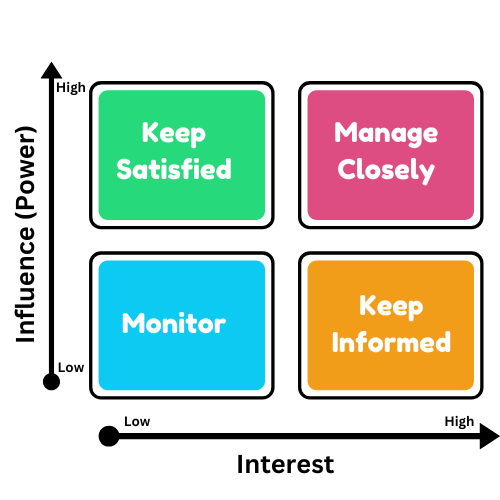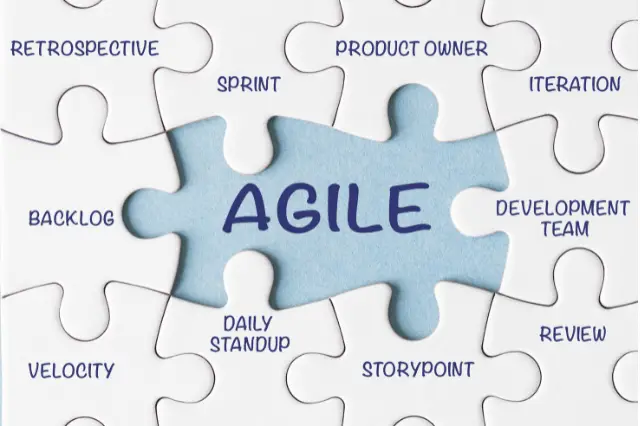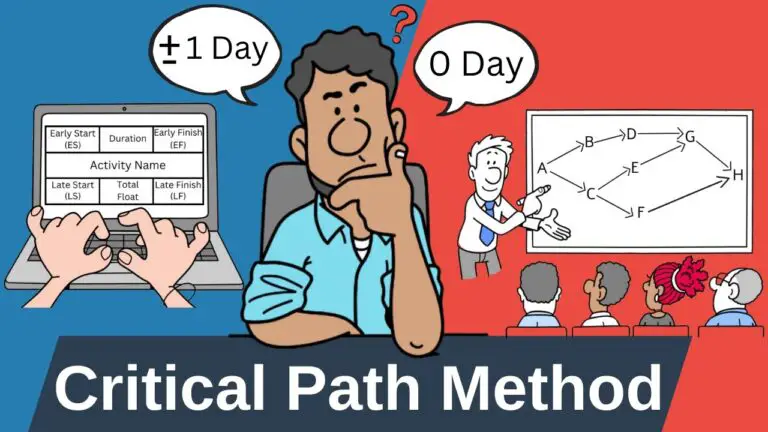Last Updated on June 28, 2025 by andrewshih
Managing stakeholders effectively is critical to the success of any project.
The Stakeholder Influence and Interest Matrix is a powerful tool that helps project managers prioritize and engage stakeholders based on their level of influence (power to impact project outcomes) and interest (level of concern or engagement in the project).
This guide explores the matrix, its quadrants, and how to use it to streamline stakeholder communication and engagement.
What is the Stakeholder Influence and Interest Matrix?
The Stakeholder Influence and Interest Matrix is a visual framework that categorizes stakeholders based on their influence and interest in a project. By organizing stakeholders into quadrants, project managers can develop targeted strategies to manage relationships effectively. This ensures that key players are engaged and potential conflicts are minimized.
Axes of the Matrix:
- Influence (Power): The authority or ability a stakeholder has to impact project decisions, resources, or outcomes.
- Interest: The stakeholder’s level of concern or engagement with the project.
Quadrants of the Matrix

Stakeholders are categorized into one of four quadrants based on their influence and interest:
High Influence, High Interest – Manage Closely
These are key stakeholders who are both influential and invested in the project’s success. Their decisions and actions can directly impact project outcomes. Regular, proactive engagement is essential.
Examples in Project Management
- A CIO sponsoring a software project.
- A project steering committee actively involved in approvals.
Engagement Strategy
- Schedule frequent updates and meetings.
- Include them in decision-making processes.
- Provide detailed project reports.
High Influence, Low Interest – Keep Satisfied
These stakeholders have significant power but are not deeply engaged in the project. Keeping them satisfied prevents unnecessary interference or opposition.
Examples in Project Management
- A finance manager responsible for approving the project budget.
- A regulatory body overseeing compliance.
Engagement Strategy
- Share concise updates on relevant topics.
- Provide assurance that their priorities (e.g., financial control) are being addressed.
- Anticipate and resolve potential concerns proactively.
Low Influence, High Interest – Keep Informed
These stakeholders are highly interested in the project but lack the authority to influence outcomes. Transparency and regular communication keep them engaged and supportive.
Examples in Project Management
- Team members not involved in decision-making but are affected by project outcomes.
- End users are excited about new system features.
Engagement Strategy
- Send periodic project updates.
- Provide opportunities for feedback and involvement in non-critical areas.
- Use newsletters or town halls to share progress.
Low Influence, Low Interest – Monitor
These stakeholders have minimal influence and limited interest. While they require minimal engagement, it’s important to monitor for changes in their status.
Examples in Project Management
- External vendors providing minor components.
- Peripheral departments with minimal interaction.
Engagement Strategy
- Limit communication to essential updates.
- Monitor for any shifts in influence or interest.
Why is the Stakeholder Influence and Interest Matrix Important?
- Prioritization: Focus efforts on stakeholders who matter most to the project’s success.
- Tailored Communication: Ensure stakeholders receive the appropriate level of information and involvement.
- Conflict Prevention: Identify influential stakeholders who might become blockers if their concerns are ignored.
- Resource Efficiency: Avoid over-engaging stakeholders with low influence and interest, allowing time and resources to be allocated effectively.
How to Use the Matrix
1. Identify Stakeholders
Compile a comprehensive list of stakeholders using tools like brainstorming, stakeholder analysis workshops, or expert judgment. Include internal and external parties.
2. Assess Influence and Interest
Evaluate each stakeholder’s authority and engagement level. Use interviews, surveys, or historical data to make informed assessments.
3. Plot Stakeholders
Place each stakeholder in the appropriate quadrant of the matrix. This visual organization helps prioritize engagement efforts.
4. Develop Stakeholder Engagement Strategies
Create customized strategies for communication, involvement, and monitoring based on their quadrant. For example:
- Manage closely: Involve in key decisions and provide detailed updates.
- Keep satisfied: Share focused updates addressing their priorities.
- Keep informed: Provide regular updates and collect feedback.
- Monitor: Engage minimally but remain alert to changes.
5. Revisit Regularly
Stakeholder influence and interest can evolve over time. Update the matrix as the project progresses to ensure continued alignment.
Practical Example: Software Development Project
Imagine managing a software project for a large corporation. Here’s how the matrix might apply:
- High Influence, High Interest: The CIO is deeply invested and has the power to shape outcomes. Regular updates and involvement in decisions are essential.
- High Influence, Low Interest: The finance manager oversees the budget. Periodic financial reports and assurance of budget adherence keep them satisfied.
- Low Influence, High Interest: A marketing team member is excited about the project’s impact on campaigns. Regular updates maintain their enthusiasm.
- Low Influence, Low Interest: A vendor providing minor components requires minimal communication but should be monitored for any changes in their role.
PMP Exam Tips
If you’re taking the PMP exam, here’s what to remember:
- Understand the characteristics of each quadrant and what action is expected.
- For scenario-based questions, use the matrix to determine the most appropriate response. For example:
- High-power, low-interest stakeholders should be kept satisfied with executive summaries.
- Low-power, high-interest stakeholders should be involved in feedback but not decision-making.
- Look for action verbs in answer choices – PMI tends to favor keywords like engage, consult, evaluate, and collaborate.
- Be wary of answers that jump to escalation or take a passive stance. PMI favors proactive and collaborative leadership styles.
Key Takeaways
- The Stakeholder Influence and Interest Matrix is a practical tool for stakeholder prioritization and engagement.
- Focus efforts on stakeholders with high influence or interest to ensure alignment and project success.
- Tailor communication strategies to meet the specific needs of each stakeholder group.
- Update the matrix regularly to adapt to changing dynamics throughout the project lifecycle.
Mastering the Stakeholder Influence and Interest Matrix enhances your ability to manage stakeholder relationships effectively, ensuring smoother project execution and better outcomes.
Whether you’re leading a small team or managing a complex initiative, this tool is invaluable for driving engagement and alignment.
FAQ
Can the matrix be applied to Agile projects?
Yes, the matrix is highly adaptable to Agile projects. In Agile, stakeholder dynamics can change quickly due to iterative delivery and feedback cycles. The matrix helps teams identify key stakeholders to engage during sprint planning, reviews, and retrospectives.
How do you measure a stakeholder’s influence and interest accurately?
Accurate measurement involves gathering insights through interviews, surveys, historical project data, and stakeholder feedback. Assess influence based on their authority or decision-making power and interest based on their active engagement or level of concern for project outcomes.
Can the matrix help manage conflicting stakeholder priorities?
Yes, the matrix aids in identifying stakeholders with competing priorities by visualizing their influence and interest. This helps project managers develop strategies to address conflicts, such as prioritizing high-influence stakeholders or finding compromises that align with the project’s overall objectives.
How is the matrix used in cross-functional teams?
In cross-functional teams, the matrix helps clarify the roles and expectations of stakeholders from different departments. For example, it identifies which stakeholders require regular updates and which need minimal involvement, streamlining communication and decision-making.
How does the matrix support conflict resolution
The matrix highlights stakeholders with high influence who may have conflicting interests. By focusing engagement on these stakeholders and using tailored communication strategies, project managers can proactively address disagreements and align stakeholders toward shared goals.
What are the common pitfalls in using the matrix?
Common pitfalls include failing to update the matrix as stakeholder dynamics change, underestimating the influence of less vocal stakeholders, and neglecting to align engagement strategies with the specific needs of each quadrant. Avoid these by revisiting the matrix regularly and maintaining open communication.



